In this guide I have gone over some of the different types of tyre wear that you can expect to find on track day tyres around the circuit paddock. My intention here is to help you learn more about bike tyre wear so you are better equipped to deal with a nasty tear if/when it rears its ugly head.
However, like most tyre based guides, the nature of the subject is quite complex, so it’s not as easy as saying this causes that, or that causes this (especially when talking about suspension adjustment) so please take this as being a somewhat simplified guide to motorcycle tyre wear, not the definitive resource. I’ll leave that to Mr Dave Moss. So let’s get on to the first type of tear.
Cause – Cold tear is caused by the tyre being overinflated. When the tyre is overinflated the contact patch on the ground is too small so it cannot generate heat that is widespread enough to bring the carcass of the tyre up to operating temperature. Instead what happens is the surface of the tyre super heats very quickly while the carcass stays below operating temperature, so the surface of the tyre is ripped straight off.
Symptoms – The tears are in fact quite deep into the carcass and are somewhat fingernail shaped. If you can get a fingernail under them and almost peel a sizable chunk of the rubber back off the surface of the tyre then this is a sure fire sign of cold tear.
Cause – Hot tear is caused by the tyre being underinflated. An underinflated tyre causes the contact patch to be too large on the ground which in turn means the tyre overheats. When the whole of a tyre over heats, the surface gets hot and is melted off very quickly and is pitched away due to the centrifugal force created when the tyre spins.
At first glance it’s quite similar to cold tear but because the whole tyre is overheating instead of just the surface, the rubber comes off with less effort as opposed to being ripped off a cold carcass like you see with cold tear, this then means hot tearing isn’t as deep.
Symptoms – As said above, it doesn’t take as much for the surface rubber to come off of an underinflated tyre because the whole tyre is overheating, so the tears on a tyre experiencing hot tear are fairly shallow and more spread out and you shouldn’t be able to get a fingernail deep under them like you can with a cold tear.
Also you will notice when looking at the tyre that the tears come down and into the centre of the tyre in an arc shape because of the centrifugal force of the tyre.
When we start talking about suspension and how incorrect settings can affect tyre wear, it’s difficult to explain what symptoms mean what because not every form of wear is unique to one particular component of the suspension. However, below I have outlined some points that should help you better determine if your tyre problems could possibly be suspension related.
If your rear suspension settings (rebound, compression, sag or spring rate) are incorrectly set to the point where they are then asking the tyre to act as a part of the suspension, you are immediately going to see some unusual wear or tearing because the tyre simply wasn’t designed to be used in that way.
To the untrained eye, tyre wear brought on from incorrect suspension settings could quite easily be palmed off as a pressure related problem (hot or cold tear), but there are some differences and some questions you can ask yourself to get you started on the right path to fixing it.
Do you know you have the right spring? – If your spring is either too hard or too soft for your weight, the carcass of the tyre will be put under a lot of strain because it’s being asked to act as a significant part of the suspension what with the spring not doing its job properly. This means the tyre ends up quickly shredding itself to pieces with incorrect loads.
Is the affected area uniform in width? – Have a look at the thickness of the tear. If you notice that the width of the tear is not uniform and changes considerably as you follow it around the tyre, then this is a good indicator that something is wrong with the suspension, usually rebound being out of adjustment. The picture to right demonstrates this.
The picture to right demonstrates this.
Does the tear go all the way around? – If it does, that may be poor tyre pressure or geometry.
However if it doesn’t and you follow the tear around the tyre and notice that it is not a continuous tear i.e. there is an affected area, then there’s a sizable area where it’s clean, then there’s some more damage, then it goes clean again, this is another indication that a suspension setting is out, most probably rebound or compression, or even a combination of them both.
Are the edges of the tread raised? – If you have a raised area on either the leading or back edge of the tread, this is a strong sign that rebound damping on the forks or shock is set either too fast or too slow. Usually if it’s on the leading edge rebound is too slow, and if it’s on the back edge it’s too fast.
By answering the above questions, you should be able to determine whether or not you have a suspension related issue.
Not enough weight on the front
Cause – This type of motorcycle tyre wear is not quite as common as things like hot or cold tear as it comes from an incorrect geometry set up which usually affects the front tyre. What you see in the picture is a result of there not being enough weight on the tyre so it cannot get to operating temperature.
This means it cannot get proper grip or traction and as a result the front tyre pushes and drags across the ground when the rider gets on the throttle, rather than rolling over it as it should. The surface is then super heated and subsequently torn up.
Symptoms – With not enough weight on the front, what you’ll see is a much smaller band of tearing that looks very similar to hot tear on a rear tyre, only the band will be about 5-10mm thick, usually about half way between the centre of the tyre and the edge. Also, it will typically be uniform all the way around the tyre.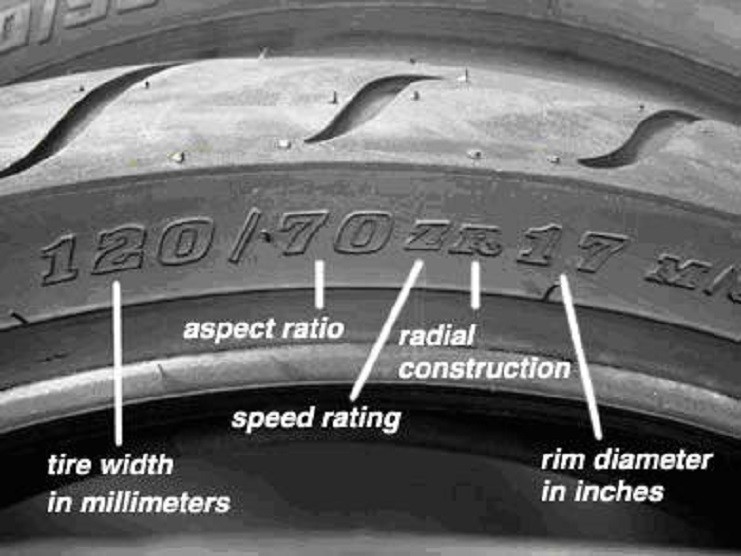
Too much weight on the front
Cause – As the above heading would suggest, the other type of geometry tear is too much weight on the front. What happens in this instance is that when you start to turn the bike into a corner, because of the excessive weight on the front it will actually plough across the ground (rather than rolling), and it’s only when you have finished turning the bike and you get back on the gas that you take the weight away from the front end and the tyre is relieved.
As well as having too much weight on the front, this type of tear can often be caused by the front end being too soft in conjunction with too much weight.
Symptoms – With a geometry tear where there’s too much weight on the front it will be the edge third of the tyre that is showing signs of incorrect wear, so the affected area is quite large.
If your tyre is showing bad wear patterns on the edge third, where the start of the wear pattern (the bit closest to the middle of the tyre) follows the circumference of the tyre uniformly, you can be pretty sure you’re suffering from geometry tear and have too much weight on the front.
You often see the question come up ‘why are my tyres blue’ or ‘what’s this blue stuff on my tyres’ with people suggesting that when you see it the tyres are done. This isn’t completely true.
What makes it blue? – Motorcycle tyres actually contain oils that keep the tyre soft and the blue/green tint you can see on your tyres is just the oils coming to the surface.
Why are they on the surface? – After the tyres have been used to the point where they gain significant heat, when they cool down again (this is one heat cycle) the oils in the tyre will often come to the surface. When you go back out and ride the bike these surface oils are scrubbed off and it’s only when you come back in and let the tyres cool down again that you’ll see more oils coming to the surface.
Each time you take a tyre through a heat cycle you are losing the oils that keep the tyre soft, so the more heat cycles a tyre has been through the less effective the rubber is going to be for you.
As a side note, heat cycles will affect track tyres a lot worse than road biased tyres, as road tyres are expected to go through these cycles.
So we know what we don’t want to see in terms of tyre wear, but what DO we want to see?
Have a look at the picture to the right, this is what you’re looking for. If you have a pattern like the one in the picture which looks like a beach where the tide has gone out, you’ve nailed it.
This doesn’t mean to say it will give you optimum performance (racers often sacrifice tyre life for better performance) but it does mean you are highly likely to see great longevity from your tyre with enough grip for any track day rider.
Motorcycle tyres are very expensive and probably the biggest expense for any track day rider or racer (apart from track time maybe), so making sure we are best equipped to deal with a tyre wear problem if it crops up is extremely important for keeping your tyres, and your wallet in good condition.
Taking the above advice into account I would like to think you will now be able to spot some of the clues and tell tale signs that show up when we experience unsavoury tyre wear, and as a result get on top of it as soon as possible before it ruins your tyres.
It’s also worth noting however that this is a fairly simplified guide to tyre wear and tearing as there are a multitude of factors that come into play such as pressures, suspension make up, how the rider rides the bike, and even the nature of the track where the problems occur, so all I have intended to do for you here is give you some baseline knowledge so you can head in the right direction to getting your tyre problems fixed. Something I hope I’ve achieved.
Other than that, keep one eye on those hoops ladies and gents!
Credit
I’ve got to give a lot of credit to Dave Moss of Dave Mose Tuning for this article. The above is what I’ve learned from watching and reading a lot of the free information he gives out on judging tyre wear. There isn’t really a quality resource for this subject so we are very fortunate to have Dave do the best he can to teach us track riders about bike tyre wear problems.
There isn’t really a quality resource for this subject so we are very fortunate to have Dave do the best he can to teach us track riders about bike tyre wear problems.
Added on January 7, 2020 The News Wheel
No Comments
Decrease Font Size Increase Font Size Text Size Print This Page Send by Email
This article is sponsored by 2wheel.com.
Photo: PixabayWhether you’re ripping around a motocross racetrack or taking an unforgettable road trip on your favorite cruiser, you need a reliable set of tires. Don’t let worn-out tires cause a blow-out at the worst possible time, but learn how to spot signs of motorcycle tire wear. Shop for the best motorcycle tires online at the first sign of worn-out tires to stay safe on two wheels wherever you ride.
Check your tread wear indicatorAll motorcycle tires have wear pattern indicators, so the trick is to find the signs of each type of tire.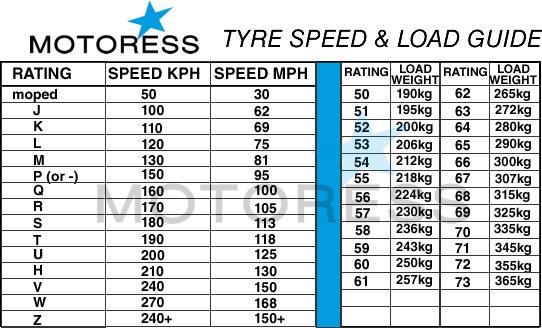 Cruisers, sportbikes, and dirt bikes all have slightly different wear patterns and tread patterns, but the basic signs of wear remain the same.
Cruisers, sportbikes, and dirt bikes all have slightly different wear patterns and tread patterns, but the basic signs of wear remain the same.
Look for a triangle imprinted on the side of your motorcycle tire. This should point to a line of rubber in your tire. This line is the tread wear indicator for your particular type of tire. When it’s worn-out or level with the top of the tread grooves, it’s time to retire your tires and pick up a new set.
Signs of unusual wearIn a perfect world, your tread wear pattern will be perfectly worn around the entire tire and other signs of wear will also be equal. However, there are many situations that can cause unusual wear. Look for these signs of wear pattern issues that may require more than a new set of Harley tires online:
Wear on a single side is typically caused by underinflation.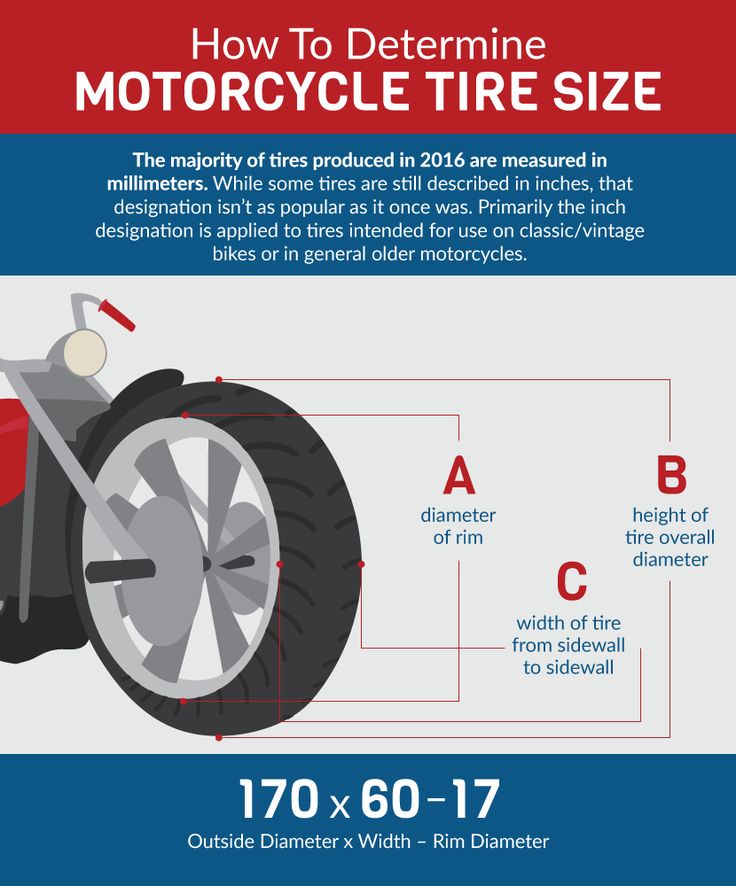 When your tire doesn’t have enough air, it increases pressure on the sides of the tread pattern. Similarly, overinflation can cause the center of your tire to wear out more quickly.
When your tire doesn’t have enough air, it increases pressure on the sides of the tread pattern. Similarly, overinflation can cause the center of your tire to wear out more quickly.
If you’ve been riding the brakes a little too hard, you’ll notice increased wear on the front tire. This is particularly common if you take a lot of curves on your normal ride. Unusual indentations, tears, and cupping can all be caused by inflation issues or improperly adjusted shocks.
All of these issues can affect the lifespan of your tires. If you start to notice one or more of these wear pattern issues, you may need to replace your tires before the tread wear indicator tells you to. Be sure you also take steps to correct the issue, or your brand-new tires will soon have the same wear issues.
Where to find the best replacement motorcycle tiresEven the best tires need to be replaced eventually. When it’s time to swap out those old tires for a beautiful set of race-ready or road-ready rubbers, shop online to compare your favorite brands and learn more about different tread types.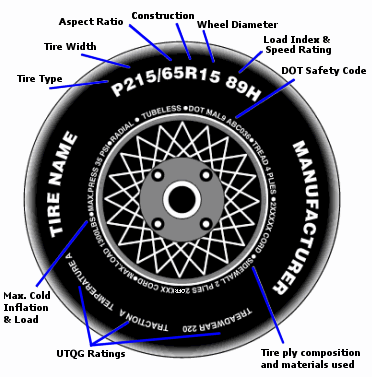 Leading online stores have all the information you need, from comprehensive Progressive 422 shocks review information to side-by-side tread reviews. Once you find the tires for your ride, it’s time to swap them out and enjoy improved traction and fuel economy for all your adventures.
Leading online stores have all the information you need, from comprehensive Progressive 422 shocks review information to side-by-side tread reviews. Once you find the tires for your ride, it’s time to swap them out and enjoy improved traction and fuel economy for all your adventures.
The News Wheel
The News Wheel is a digital auto magazine providing readers with a fresh perspective on the latest car news. We’re located in the heart of America (Dayton, Ohio) and our goal is to deliver an entertaining and informative perspective on what’s trending in the automotive world. See more articles from The News Wheel.
It's no secret that motor rubber is considered a consumable. Quite expensive, it must be said. We all remember from traffic rules tickets that motorcycle rubber wear is considered acceptable up to 0.8mm. But not to run with a ruler around the motorcycle every morning? Moreover, rubber wear is different, because not only a worn tread is the reason for replacing motor rubber.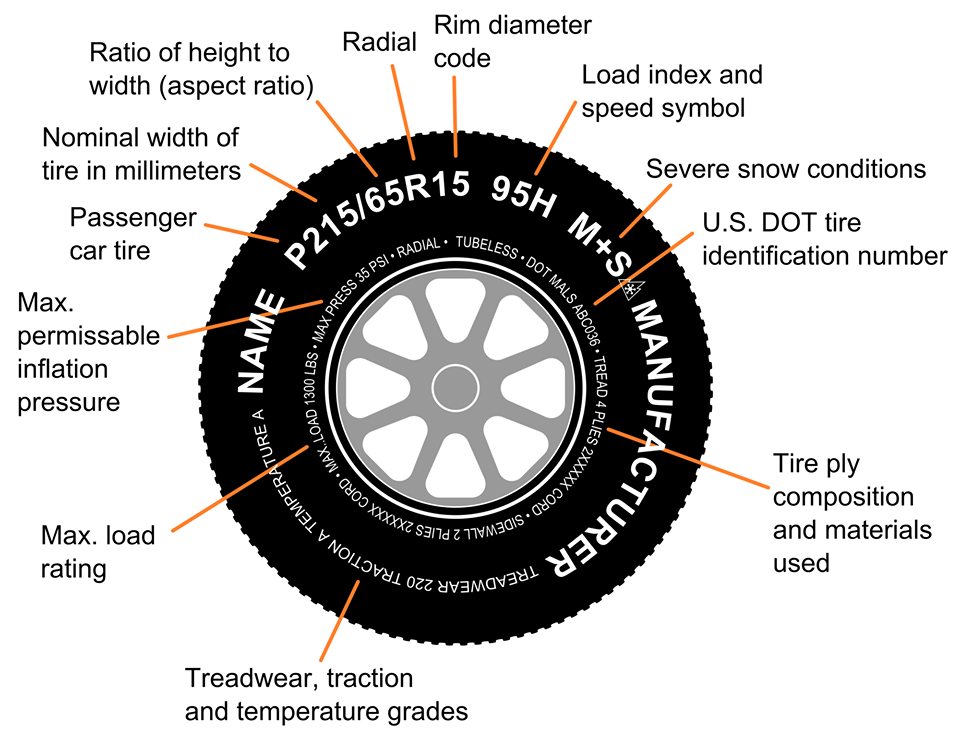
Consider the reasons for changing tires:
The first and main reason rubber is scrapped. Tire tread wear is determined visually by indicator pointers. On the tire, if you carefully inspect it, there are special marks inside the tread pattern. These tubercles are not a manufacturing defect, but that little thing that tells you that it is dangerous to use rubber further. When the tread pattern is even with the bump, you should buy a fresh tire. It's simple, you don't even need a ruler.
In fact, a tire wears out the fastest at two points in its life - during break-in and after tread wear. The smaller the pattern on the rubber, the faster it will become unusable, it is worse to keep the road and slide in every possible way on a wet surface. Just in case you think the rubber wears evenly and after the 0.8 mm critical point you still want to ride, I'll disappoint you, because after this point the rubber will begin to wear off at an amazing deserter speed.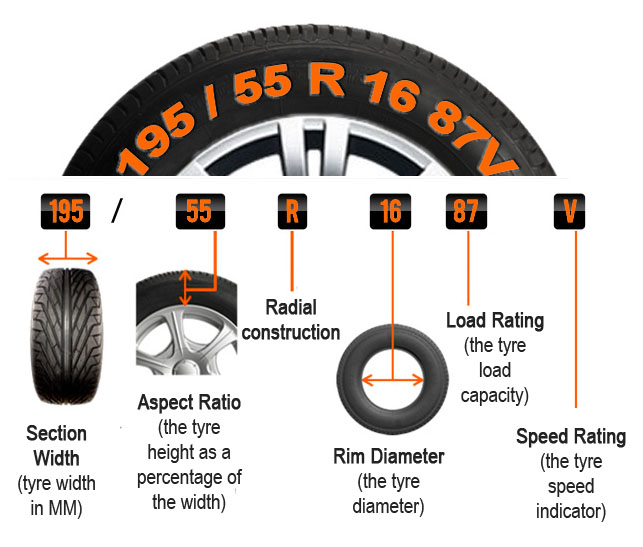
Cold tires wear out more slowly than warm tires. By the way, tires with lower pressure warm up faster, and therefore wear out more intensively. Low pressure affects wear at the edges of the tire, and high pressure contributes to abrasion in the center.
What did you think, bought a rubber, put it on and it will always be like new? Alas, nothing lasts forever under the moon, and even rubber is treacherously aging. The first signs that it is time for rubber to retire are cracks. Large or small, depends on storage conditions and how sad the tire is with life. Additional signs of the age of rubber - the color turns from black to gray, loss of elasticity, hardening and roughness of the surface.
It is logical that mechanical damage includes everything that has affected the rubber from the outside, the vast majority are impacts and punctures. Riding habits, bad landings, even the influence of suspension settings can damage the integrity of the tire.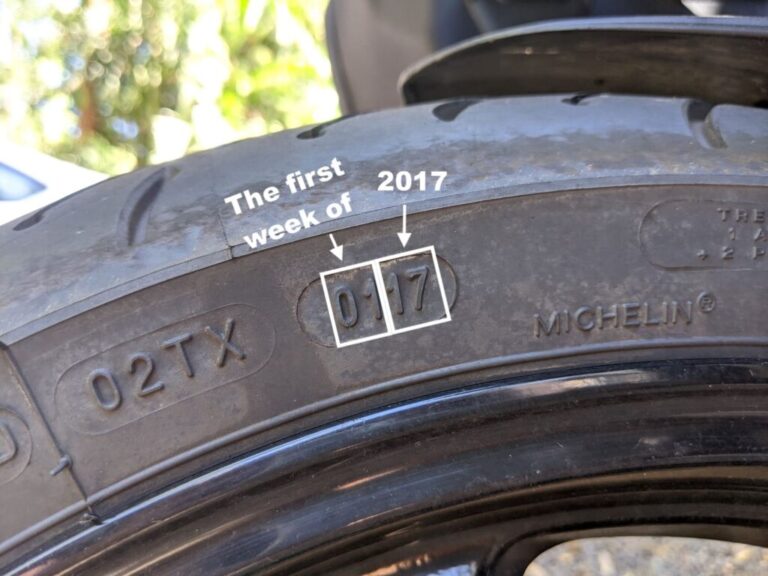
The combustion of rubber and spools should be considered as a separate point here. Since not every tire is used in light modes. Have you been to race tracks or demonstrations? If so, then you're familiar with the smell of burnt rubber, especially if you've watched someone drift. By spools, collected rubber in different parts of the tire, you can determine how the driver drove, especially true for track riders.
All damage that the rubber receives during storage, as well as in the process of uneven loading, is placed here. It happens that bulges appear on the tire, a sure sign that it's time to rest. Any deformation of the tire inevitably leads to a change in the distribution of force and to a shift in the contact patch, so such rubber will have to be changed to fresh.
In fact, the average life of any tire is 5-7 years, but a lot depends on how the owner treats his car. Aggressive driving, improper seasonal tire storage, unrepaired suspension/balancing problems, incorrect pressure and other errors can significantly shorten tire life.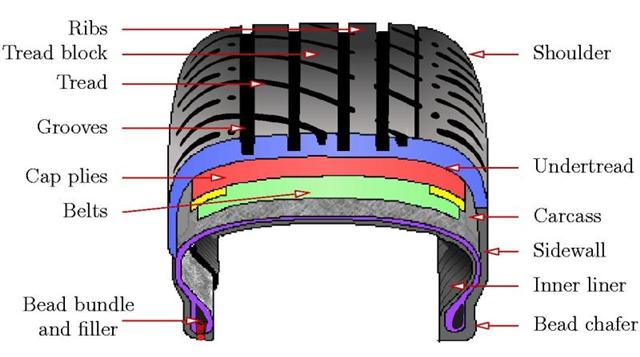 But worn tires can be a serious problem on the road: an increased risk of uncontrolled skidding, hydroplaning, even accidents is the price that drivers and passengers have to pay for using old tires.
But worn tires can be a serious problem on the road: an increased risk of uncontrolled skidding, hydroplaning, even accidents is the price that drivers and passengers have to pay for using old tires.
Each manufacturer indicates the so-called wear index on the tire profile, which most often looks like the inscription “Treadwear 100” and means a maximum of 48,000 km on a standard road surface (polygon). In a real environment and often not the most ideal roads, this number actually needs to be divided by 1.5 - we get 36,000 km.
By analogy, if the wear resistance index is 150, then this means “factory” 72 thousand km, 200 - 96 thousand km., and so on.
What are the dangers of worn tires on the road:
adhesion to the roadway deteriorates, which leads to an increased likelihood of skidding, accidents, hydroplaning in case of rainy weather;
reduced cross-country ability in off-road conditions;
increases the risk of a tire puncture while driving.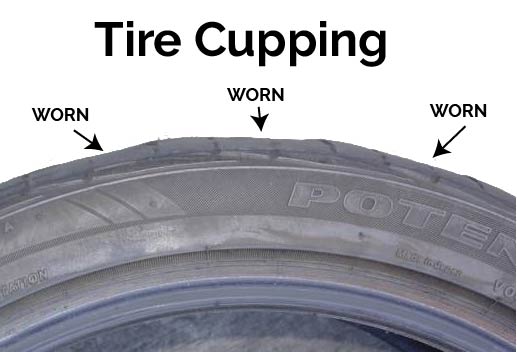
It is also worth remembering that the issue of tire wear is regulated by traffic rules, and you can get a fine for using “bald” rubber. Knowing what maximum tire wear is acceptable, this is easy to avoid: 1.5-2 mm for summer, and 4-5 mm for winter (a more accurate figure is indicated by the manufacturer).
1. According to the wear indicator on the tire. To find this indicator, you need to inspect the side of the tire and find one of the markings: a triangle, a company logo, a snowflake, or the abbreviation TWI. If the tread has worn down to this indicator, it means that the tire needs to be disposed of urgently.
2. Many people in the old fashioned way prefer to use a 10-kopeck coin. Insert it into the tread with the inscription "10 kopecks" towards you, and if it is visible, the wear level is too high, you need to replace the tire. This method is convenient, but not entirely accurate: by measuring wear in different parts of the tire in this way, it will be difficult to estimate its unevenness by eye, and this is also an extremely important indicator.
3. It is optimal to use a special gauge, depth ruler or caliper for these purposes. This will allow you to measure the wear of the tread in different parts of the tire with an accuracy of up to a millimeter and understand if there is uneven wear.
If measurements show different results in different parts of the tread, it is important to determine exactly how your tires wear in order to understand where and what the operating error is.
If the tread wears more on the sides and the center wears off less, this means that the tire pressure is insufficient and the contact patch with the road is not correct. This leads not only to poor vehicle stability, but also to increased fuel consumption.
If the tread is worn down the middle but the sidewalls are fine, then your tires are overinflated. Sometimes this is done intentionally in order to save fuel, but in this case, the tires will still have to be changed ahead of schedule.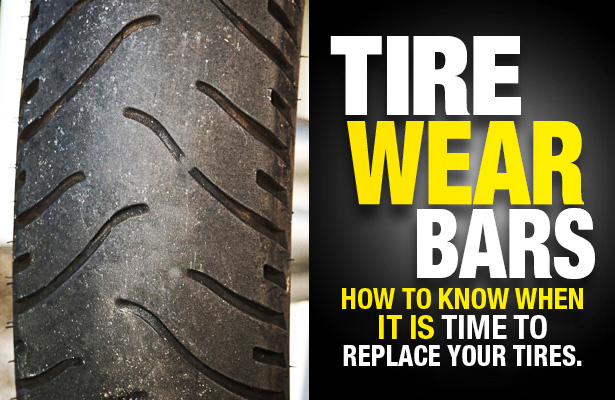
There is also the possibility of increased wear on the inside or outside of the tread - this indicates an incorrect camber. A visual table with wear options and their causes:
Cracks on the sides of tires can indicate frequent off-road driving, improper storage, low-quality rubber or long service life, as well as incorrect tire pressure.
Bulges or "hernias" on the sides of the tires appear as a result of the side part hitting hard obstacles. Tires with such damage are not recommended.
Dents on the tread indicate insufficient depreciation and unadjusted camber. Having found such damage, it is necessary to drive the car to the service and make sure that the suspension is in good condition.
Individual wear spots on the tread indicate aggressive driving / braking, skidding with wheel locks, or prolonged parking of the car in one position.
Most often, this is required for the sale and purchase of used tires in order to orient the buyer in the degree of their wear. Many sellers give this figure at random, but this method has nothing to do with the actual assessment of the degree of tire wear. It is also important to understand that a conditional 50% wear for a summer tire is an acceptable value, while 50% wear of a winter tire tread is a sign that the tire cannot be used. Therefore, it is important to know how to accurately determine the percentage of tire wear so as not to get into an unpleasant situation.
Many people divide the actual tread height by the height of the same, but new tire, and get a certain percentage of wear. This would be correct, if not for one BUT: we cannot physically erase the tread to zero, and the law prohibits the use of tires with a tread below the permitted values.
You can calculate actual tire wear by dividing the difference between the new tire height and the actual tire height by the difference between the new tire tread height and the minimum possible tread height for that tire, and then multiplying this number by 100.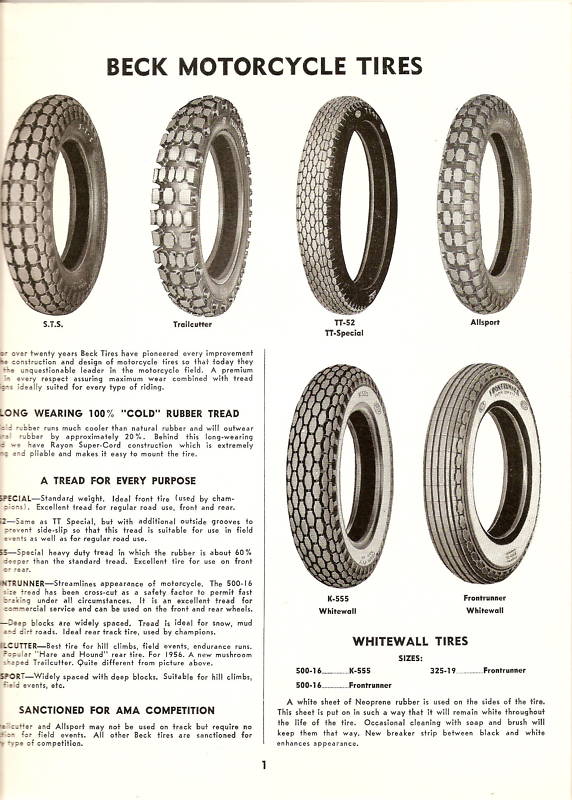
If it is impossible to find out the height of the same, but with a new tire, use the average values of your tire type:
| Tire type | Average tread height at start of use |
| Winter tires with Scandinavian tread | 10 mm |
| Winter with regular or asymmetric tread | 9 mm |
| High-speed winter | 7 mm |
| Summer tires with classic tread | 8 mm |
| Summer speed | 7 mm |
You can check summer tires for wear a little less often than winter tires, since in summer the tread depth is not so important for patency.
If you have assessed the condition of your tires on all of the above factors and realized that the tires are worn out, be sure to replace them with new ones as soon as possible.